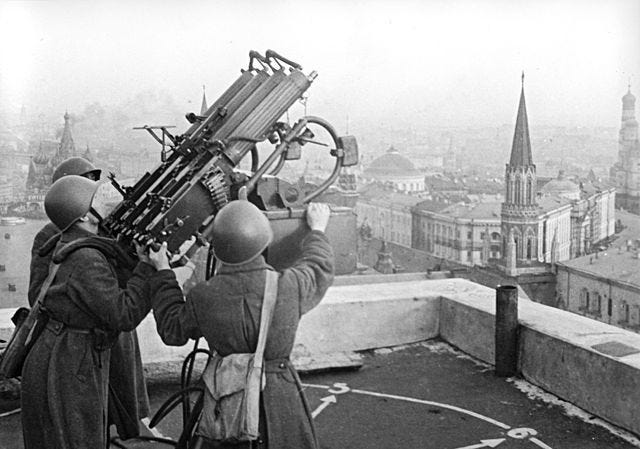
When Hitler launched Operation Barbarossa in June 1941, the threat to Moscow became almost immediately clear. Despite several warnings of an impending invasion, the German assault against the Soviet Union caught Stalin by surprise and the initial Soviet defensive effort was marred by scenes of chaos and disorder. With the Red Army depleted and demoralized in the wake of pre-war purges of its officer corps, the German invaders rapidly advanced eastwards across Soviet territory — with the Soviets suffering 2,663,000 troops killed and 3,350,000 taken prisoner within the first six months of the conflict.
At the outset of Barbarossa Hitler declared: “Before three months have passed, we shall witness a collapse in Russia, the like of which has never been seen in history” and as the Wehrmacht experienced a wave of early victories, Hitler’s prophecy appeared to be on the verge of becoming reality. The German strategy in 1941 aimed to see a breakneck advance across the Soviet Union and a decisive defeat of the Red Army in a matter of months, mimicking the swift German success in France seen in 1940. This involved a three-pronged assault towards Leningrad, Moscow and Kiev — with Hitler remaining confident that the Soviet defenders were on the verge of collapse.
Army Group Centre would be tasked with the advance towards Moscow and in July they captured Smolensk, known as the gateway to the Russian capital. By September 1941, Hitler now found his forces approaching the gates of Moscow and German commanders began dreaming of a lightning victory over their most bitter foes. With the capital now threatened, a final assault on Moscow was initiated with the goal of dealing a critical blow to Soviet resistance.
The road to Moscow
On 30th September Hitler initiated Operation Typhoon and the race towards Moscow was now well and truly underway. Stalin had 800,000 troops available to defend Moscow’s western approaches, and the Soviets began constructing defensive lines around key cities on the road to their capital. However, these defensive positions would fail to hold the German onslaught — and Orel, Briansk and Vyazma would fall in rapid succession, with a staggering 663,000 Soviet prisoners being taken along the way. After the fall of Orel, German General Alfred Jodl reported to Hitler “We have finally and without any exaggeration won the war!” and expectations of an imminent Soviet collapse grew with each victory.
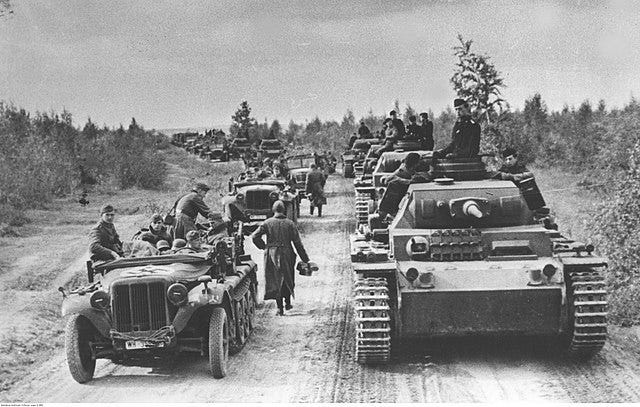
With the situation looking exceedingly dire Stalin needed a savior, and on 10th October he made one of the most crucial decisions of the whole war — handing responsibility for the defense of Moscow to General Georgy Zhukov. A man of humble origins, Zhukov was known as a straight-talking leader who had a knack for giving honest feedback from the front line, which helped to set him apart from the fearful yes men who often surrounded Stalin.
By the time he took up the command Zhukov found that he had only 90,000 troops at his disposal spread across a vast 150-mile radius, having fallen from 800,000 at the start of September. Many of the remaining defensive units consisted of stragglers who had fled eastward amidst the earlier chaos, with whole army groups becoming detached from one another. The scene was made even more disorderly by the frantic nature of the intelligence coming from the front line, with Soviet commanders themselves unsure of where exactly the Germans were located.
Stalin stands firm
In the city of Moscow itself, activity reached a frenzied pace as its residents flooded to offer their services to the war effort. Several volunteer combat divisions were raised, and two belts of defensive trenches were dug around the city — including by women and children. With German troops reaching the Mozhaisk line (Moscow’s main line of fortifications) by the middle of October, on 15th October Stalin ordered that the Communist Party, government officials and the General Staff be moved out of the capital and relocated to the city of Kuibyshev. The sight of functionaries fleeing Moscow sparked a wave of panic in the city, with civilians blocking roads and overwhelming train stations as they attempted their own hasty escape. Martial law was soon imposed.
To calm the situation, Stalin himself remained in the capital — and this soon helped alleviate fears within the city. A defiant Stalin proclaimed that “Moscow will be defended to the last!” as he attempted to rally Muscovites for the coming battle, but for the time being his greatest ally would be the weather. On 31st October Operation Typhoon ground to a halt as rain and melting snow made roads impassable and the German supply line became strained. This was all too familiar to the Soviet defenders, who knew this period as Rasputitsa — quite literally the time without roads.
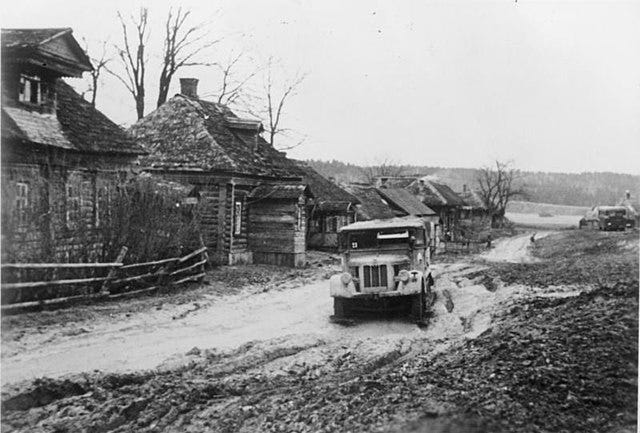
Stalin used the pause in battle to organize 10 new armies and supply over 1000 tanks to aid the defensive efforts, including the new T-34 tank (albeit in limited quantities). Whilst German troops suffered from a lack of winter equipment and uniforms, their adversaries also used this period to stock up on winter gear such as snow suits and sledges, which would prove pivotal in the winter combat that was to follow.
With the Germans now stationed only 50 miles from Moscow, on 7th November a military parade was held on Red Square to mark the anniversary of the Bolshevik Revolution, with Stalin again seeing the propaganda and morale boosting potential of such an occasion. On the eve of the celebration, Stalin gave a rousing speech to an assembled crowd — urging that “our task now will be to destroy every German, to the very last man! Death to the German invaders!” and warning that “if they want a war of extermination they shall have it”. The celebration was however to be short lived and on 15th November the German advance resumed once again, setting the scene for the fierce clash that would soon envelop the city.
The Battle for Moscow
The German strategy to capture Moscow revolved around two coordinated assaults, which in turn would trap the city in a pincer movement and leave the defenders surrounded. Third and Fourth Panzer Groups would cross the Moscow-Volga Canal and approach Moscow from the northeast, while Second Panzer Army was to advance on Tula and assault the capital from the south. Despite chronic fuel and ammunition shortages on the German side, the attack began amidst heavy fighting — with the Soviets successfully halting General Heinz Guderian’s Second Panzer Army on the southern flank. These supply shortages would soon become so severe that Guderian himself requested that the assault be called off.
In the north, the German offensive yielded greater results. The attackers managed to successfully cross the Moscow-Volga Canal, with Konstantin Rokossovsky’s 16th Army unable to hold its position — and German troops now found themselves within 20 miles of Red Square. By late November, Zhukov would see his motorized forces dwindle down to only three tank divisions, three motorized rifle divisions, twelve cavalry divisions and fourteen tank brigades — albeit with a significant contingent of anti-tank units still in the region.
Faced with another potential calamity, the Red Army had however learnt lessons from the bitter defeats of September and October. Zhukov worked tirelessly to keep in contact with the front line and was determined to prevent army groups from losing contact with one another as had previously happened, and by this point the defenders were able to muster 240,000 troops as additional reinforcements continued to arrive. Crucially, orders were given for Soviet soldiers to fight to the last man or face the prospect of a firing squad — averting the possibility of mass desertion.
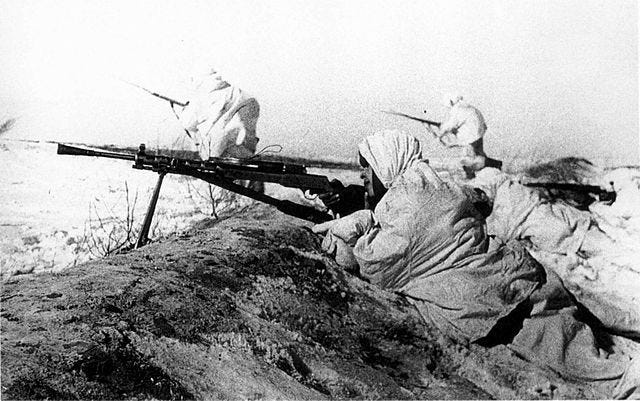
These reinforcements were quickly thrown into combat on the southern flank and on 28th November a major Soviet counteroffensive was launched. Zhukov tasked Major General Pavel Belov, commander of 2nd Cavalry Corps, to lead the offensive and allocated him the newly designated 1st Guards Cavalry Corps as additional support. Belov’s troops attacked the Germans at Kashira (50 miles northeast of Tula) and managed to infiltrate their line almost without resistance — effectively ending the southern assault on Moscow.
To the north, German soldiers reached Khimki (a city on the outskirts of Moscow) and supposedly reported being able to catch a glimpse of Red Square through their binoculars, but this was to mark the furthest point of their advance. By the end of November, the Germans had lost 25% of their effective troop strength and as Soviet counterattacks began at the beginning of December, the northern German flank rapidly started to run out of steam. On 5th December, a counteroffensive by General Mikhail Efremov’s 33rd Army finally halted the northern push towards Moscow — and amidst hostile weather and a severe lack of supplies, German General Fedor von Bock requested permission to end Operation Typhoon and prepare his own defensive positions for the winter.
The Red Army marches
Whilst dogged Soviet resistance had manage to end the immediate threat towards Moscow, Stalin still looked to deliver a decisive blow. As the German advance ground to a halt Field Marshal Walther von Brauchitsch wrote in his diary that the Soviets had “no new forces available”, with German intelligence confidently believing that the Red Army was now out of reserves. This was however to be a major miscalculation, and at the beginning of December the Soviets launched a sweeping counterattack that caught their opponents by surprise.
By now the brutal reality of the harsh Russian winter had truly kicked in, with heavy snowfall and temperatures of -15 degrees Celsius accompanying the Soviet offensive. Conditions were so hostile that German maintenance crews struggled to prevent engines from simply freezing up amidst the bitter cold. To the north of Moscow, the Kalinin Front’s 29th and 31st Armies, led by Ivan Konev, began the counteroffensive and rapidly forced the German line westward, capturing the town of Klin on 15th December and retaking Kalinin by the end of the month. To the south of Moscow, a similar counterattack by Belov’s Cavalry Mechanized Group targeted Guderian’s Second Panzer Army, and a further assault by Ivan Boldin’s 50th Army at Tula forced Guderian to withdraw to the Don River.
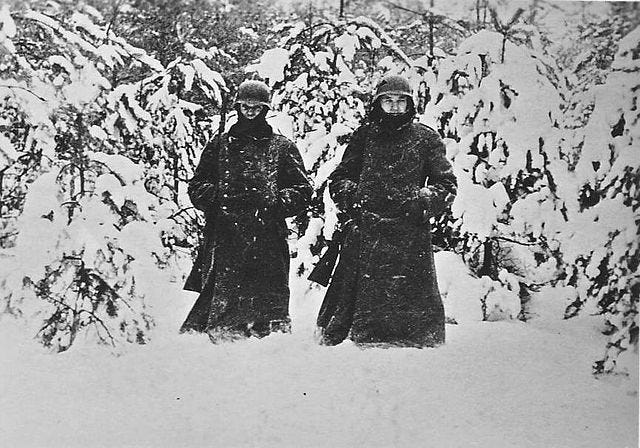
With the Soviets now on the front foot, Bock requested permission for a full-scale German withdrawal — which was denied by Hitler and would spur Bock to resign from his post on the grounds of ill health. Soon afterwards Hitler would personally assume command of the situation and promptly demanded that his commanders hold their ground at all costs, even in the face of further Soviet attacks. Luckily for the Germans, an exhausted Red Army found itself rapidly running out of steam and by January 1942, the Wehrmacht had managed to stabilize the situation and prevent the Soviets making further gains.
The defeat would however come at a great cost to the Germans, as they sustained potentially up to 250,000 casualties during the battle. A special report commissioned by the German High Command on morale levels in Fourth Army recorded the following assessment: “the men [are] completely apathetic, incapable of carrying or servicing weapons; the remnants of companies are dispersed over kilometres; they hobble along in pairs using the rifles to prop themselves up, their feet wrapped in rags. When they were spoken to, they didn’t hear or they began to weep”. As the dust settled around Moscow after weeks of heavy fighting, the downcast mood among the German rank and file contrasted sharply with the jubilation felt by their Soviet rivals.
Clash of the titans
The German failure to capture Moscow is commonly associated with the brutality of the Russian winter — and this undoubtedly played its part in the battle. However, the bitter cold and piercing temperatures of late 1941 cannot solely explain the Soviet triumph during the conflict. As noted by David Glantz and Jonathan House in their landmark history of the Eastern Front When Titans Clashed, the massively overstretched nature of German supply lines would also play a key part in the defense of Moscow, with the two historians describing the rival powers as resembling “two punch drunk boxers, staying precariously on their feet, but rapidly losing the power to hurt each other decisively”.
By the end of Operation Typhoon, the German advance had decisively ground to a halt as their supply of reinforcements ran perilously low, whilst the Soviets managed to call up additional troops and supplies at key moments in the battle. Historian Richard Overy highlights the remarkable ability of the Soviet war effort to rebuild and rearm itself after the early catastrophes of June-December 1941, in which an astonishing 20 Soviet soldiers were killed for each German casualty.
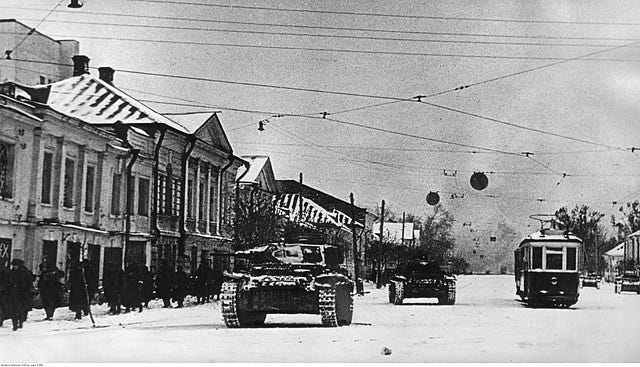
The tenacious and resilient nature of the Soviet defense also helps to explain the German defeat at Moscow, with Soviet troops showing extreme bravery and enduring great hardships throughout the struggle for the city. After months of constant defeats and bitter loses in the early stages of Barbarossa, the defenders were beginning to grow in competency and combat skill — with the Soviets utilizing home advantage (such as the use of permanent airfields, as opposed to the temporary forward bases used by the Germans) to great success.
An example of the turnaround in Soviet military prowess during the battle can be seen in the late counteroffensive to relieve the city. Through a concentration of forces during the Soviet counterattacks of December 1941 and January 1942, the Red Army was able to achieve a 2.5-to-1 superiority in personnel over the Germans to the north of Moscow and a 2-to-1 advantage in the south — showcasing the growing tactical skill of Soviet commanders during this stage of the war. The contribution of those involved in the Soviet war effort throughout this period, alongside the cruel Russian winter, help to explain the unexpected Soviet victory at Moscow.
In the context of the Second World War, the Battle for Moscow would have both practical and psychological implications for the remainder of the war. The successful defense of Moscow would serve as a major morale boost for the Soviet Union at its darkest hour — and offered proof that the fearsome Wehrmacht could be defeated. From a German perspective, the defeat ended Hitler’s hopes of a rapid victory over the Soviet Union and ensured that Germany’s war in the east would now become a campaign of attrition, which in turn suited the Soviet Union’s vast industrial capability and enormous supply of natural resources.
With years of bloody fighting to come, Germany’s war against its eastern rival was not won or lost by the setback in Moscow. However, the battle ultimately marked the start of the Soviet revival on the Eastern Front and would serve as the first major German defeat of the war, with the balance of power between the two sides now slowly beginning to shift.



